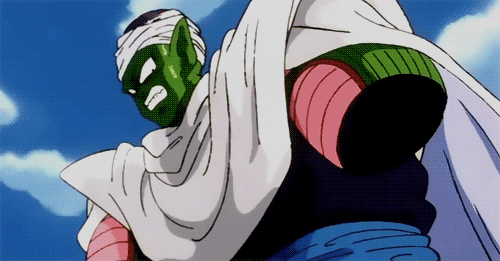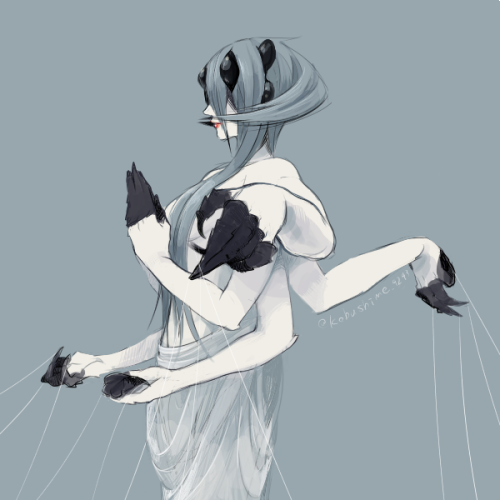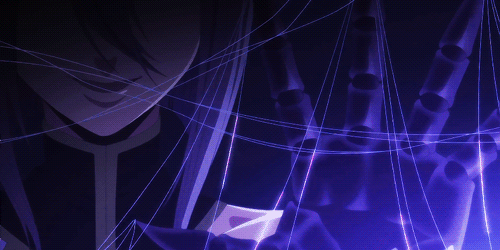The Cabucabu
They're considered an advancement of The Sigcawu People but they believe different. The similarities are clear as they too can produce webbing from any part of their bodies most, common being their fingertips.
The Cabucabu have a full spectrum of birthable colours, the colours will evolve based on the general temperature within the environment along with any multi-generational attributes accumulated over time along with diet, ie ones history can define the colour they develop.
Lighter colours with reflecting on those in colder locations while darker colours will be defined by those who tied to more hot areas, snow producing white or pale skin over time, while the desert or Brimstone Plateau can produce pure black Cabucabu.
The richness and range are tied to the location and the flow of seasons to create a single colour over generations to best match their predatory needs. It is not uncommon for generations of Cabu to change colour faster since the procreate faster.
Green Cabu are expected in high shrubbery and open pains.
Brown farmlands and heavily wooden locations.
Red will be closer to the brimstone and mountain ranges.
Blue being more coastal.
They will never make new colours, instead, they worked together, creating patches of the joining colours, it will make a camouflage effect.
The Cabucabu have a full spectrum of birthable colours, the colours will evolve based on the general temperature within the environment along with any multi-generational attributes accumulated over time along with diet, ie ones history can define the colour they develop.
Lighter colours with reflecting on those in colder locations while darker colours will be defined by those who tied to more hot areas, snow producing white or pale skin over time, while the desert or Brimstone Plateau can produce pure black Cabucabu.
The richness and range are tied to the location and the flow of seasons to create a single colour over generations to best match their predatory needs. It is not uncommon for generations of Cabu to change colour faster since the procreate faster.
Green Cabu are expected in high shrubbery and open pains.
Brown farmlands and heavily wooden locations.
Red will be closer to the brimstone and mountain ranges.
Blue being more coastal.
Mixed
Cabu colours are almost always a perfect solid colour unless mixed with other Cabucabu of different colours.They will never make new colours, instead, they worked together, creating patches of the joining colours, it will make a camouflage effect.
Basic Information
Anatomy

Though weak, they self-repair.

All Cabucabu posses biological anatomy separate from humans but externally appear female with mammaries and a shapely form. Though cultural factors will lead to them either embracing or rejecting that identity.
Genetics and Reproduction
Procreation is an excruciating affair, one which is so unnaturally painful that almost makes all Cabucabu naturally asexual. With one exception, the time of heat. None are asexual, all become aggressive. Dangerously so.
The child-rearing is a year-long and occurring in five phases, run entirely by biological need. The desperation that fills their lungs and holds them for days, sometimes weeks.
Every two months there's a seven day period of discomfort, where they bloat, gaining muscle mass and even bone density, it comes at a heavy cost becoming a painful hormone change. Some can be so severe that Cabu will lock themselves away until it has been ejected or bled away and the cycle.
They're able to fertilize an egg asexually. Asexual reproduction is rare, as conditions need to be specific. Most of them are a chemical reaction brought by a high mental intake and release. It means that one must not be weighed down by burden and stress.
Throughout history, the process of reproduction has been one of solitude. This is broken by them having partners, rarely the one who impregnated or crowned them.
Due to the excruciating and taxing process of birth which can be emotionally breaking. Mothers become murderously protective of their offspring.
There are very rare cases of a mother giving birth to anything more than two children, which is considered to be suicide as a child's medical and nutritional needs could potentially kill.
The first stage of a successful impregnation is The Gaunt. The Gaunt is a period where the fertilized egg is dissolved chemically starting with the shell until there is only the core, which will rebuild quickly, pulling nutrients heavily.
This is the second, most dangerous part of pregnancy as if one is not in the right condition they will be put into a coma, controlled by an intense biological need to hide where they will die and the child will grow by devouring the mother until there's nothing left, eating the webbing until they're able to hunt and kill on their own. Those born this way are considered psychopathic as they're born without a mother to nurture them.
If the mother manages to overpower the urge to crawl into a hole and die, they'll feed themselves and maintain their weakened state until the egg develops a new shell.
In the second phase, instinct demands they be surrounded by webbing before they'll be able to birth the egg. The eggs are large enough to dislocate a Cabucabu's entire waist at several points, ripping cartilage. It's designed to cripple and kill the mother to be eaten by the baby. This is generally avoided because the instinct can be broken by faking it; webbing the walls of their house. It's enough to start the pregnancy. A mother can either repair themselves or have someone heal them and keep them alive.
Once the egg is free, their hands and arms will twist back, holding the egg/eggs up behind their backs going from six arms and two legs to two arms and two legs as the others become incredibly dense conduits churning energy out, as raw food or digestant returning it to protein and testosterone, this is where the blueprints to a large body are formed. This is when they can grow in size, using strength they have to consume great deals of nutrients, as refined as possible. The less processed, the more likely they'll vomit or shit it out.
Upon surviving the third phase. The fourth creates the hardening of the egg. This is a dangerous phase as one could lose their arms permanently if done wrong.
With the help of another or one's commitment and webbing, they must pull free or they'll lose their arms. At this point, their arms will be extremely fragile, susceptible to rot and disease. They must be washed gently, and tightly webbed, the pressure if strong and constant enough will strengthen the arms to the point of growing back their fingers and eventually the bone by eating the same web milk as the child.
It takes a month after the hardening.
The fifth is breaking out, it's not dead but is a bloody, smelly and painful affair as the baby tries to eat its way out.
The final is the feeding stage. As there's no need for mammaries. The 'mammary' will dissolve into itself becoming functional as food. For the first week, the mother eats and vomits it back out, mixing it with their blood. The child will eat its fill until strong enough to eat off of the mother directly. The body will always prefer blood and must be weaned off for risk of attacking the mother. Its instinct is always to devour the mother.
The child-rearing is a year-long and occurring in five phases, run entirely by biological need. The desperation that fills their lungs and holds them for days, sometimes weeks.
Every two months there's a seven day period of discomfort, where they bloat, gaining muscle mass and even bone density, it comes at a heavy cost becoming a painful hormone change. Some can be so severe that Cabu will lock themselves away until it has been ejected or bled away and the cycle.
They're able to fertilize an egg asexually. Asexual reproduction is rare, as conditions need to be specific. Most of them are a chemical reaction brought by a high mental intake and release. It means that one must not be weighed down by burden and stress.
Throughout history, the process of reproduction has been one of solitude. This is broken by them having partners, rarely the one who impregnated or crowned them.
Due to the excruciating and taxing process of birth which can be emotionally breaking. Mothers become murderously protective of their offspring.
There are very rare cases of a mother giving birth to anything more than two children, which is considered to be suicide as a child's medical and nutritional needs could potentially kill.
The first stage of a successful impregnation is The Gaunt. The Gaunt is a period where the fertilized egg is dissolved chemically starting with the shell until there is only the core, which will rebuild quickly, pulling nutrients heavily.
This is the second, most dangerous part of pregnancy as if one is not in the right condition they will be put into a coma, controlled by an intense biological need to hide where they will die and the child will grow by devouring the mother until there's nothing left, eating the webbing until they're able to hunt and kill on their own. Those born this way are considered psychopathic as they're born without a mother to nurture them.
If the mother manages to overpower the urge to crawl into a hole and die, they'll feed themselves and maintain their weakened state until the egg develops a new shell.
In the second phase, instinct demands they be surrounded by webbing before they'll be able to birth the egg. The eggs are large enough to dislocate a Cabucabu's entire waist at several points, ripping cartilage. It's designed to cripple and kill the mother to be eaten by the baby. This is generally avoided because the instinct can be broken by faking it; webbing the walls of their house. It's enough to start the pregnancy. A mother can either repair themselves or have someone heal them and keep them alive.
Once the egg is free, their hands and arms will twist back, holding the egg/eggs up behind their backs going from six arms and two legs to two arms and two legs as the others become incredibly dense conduits churning energy out, as raw food or digestant returning it to protein and testosterone, this is where the blueprints to a large body are formed. This is when they can grow in size, using strength they have to consume great deals of nutrients, as refined as possible. The less processed, the more likely they'll vomit or shit it out.
Upon surviving the third phase. The fourth creates the hardening of the egg. This is a dangerous phase as one could lose their arms permanently if done wrong.
With the help of another or one's commitment and webbing, they must pull free or they'll lose their arms. At this point, their arms will be extremely fragile, susceptible to rot and disease. They must be washed gently, and tightly webbed, the pressure if strong and constant enough will strengthen the arms to the point of growing back their fingers and eventually the bone by eating the same web milk as the child.
It takes a month after the hardening.
The fifth is breaking out, it's not dead but is a bloody, smelly and painful affair as the baby tries to eat its way out.
The final is the feeding stage. As there's no need for mammaries. The 'mammary' will dissolve into itself becoming functional as food. For the first week, the mother eats and vomits it back out, mixing it with their blood. The child will eat its fill until strong enough to eat off of the mother directly. The body will always prefer blood and must be weaned off for risk of attacking the mother. Its instinct is always to devour the mother.
Additional Information
Social Structure
They support dominance hierarchies.
Naturally trying to seek out power, either to expand over it or fold under it.
Although the system is somewhat primitive, it is something, they have managed to build a survivable culture around.
They hold, a great deal of faith so powerful it is built into their DNA to the point where the most feral Cabucabu will be able to speak it.
Domineering Cabucabu calls themselves crowned Cabucabu, a tamed Cabucabu will then call those who had proven themselves "Crowned" only a crowned person has the right to lead.
Generally, almost always, this is done through violence, but over time, they've started to accept that it might not always be muscle, that proves their crown stature. Though they believe, almost exclusively in honourable battle they do look for alternatives like social crowning to become stronger.
In general, they're nomadic choosing to live alone, generally in small, thin-walled cocoons.
Naturally trying to seek out power, either to expand over it or fold under it.
Although the system is somewhat primitive, it is something, they have managed to build a survivable culture around.
They hold, a great deal of faith so powerful it is built into their DNA to the point where the most feral Cabucabu will be able to speak it.
Domineering Cabucabu calls themselves crowned Cabucabu, a tamed Cabucabu will then call those who had proven themselves "Crowned" only a crowned person has the right to lead.
Generally, almost always, this is done through violence, but over time, they've started to accept that it might not always be muscle, that proves their crown stature. Though they believe, almost exclusively in honourable battle they do look for alternatives like social crowning to become stronger.
In general, they're nomadic choosing to live alone, generally in small, thin-walled cocoons.
Perception and Sensory Capabilities

When all eyes are open, they develop incredible balance and accuracy able to measure and see objects at a greater speed, able to do the trig needed to measure distances for more accuracy than most races.
Genetic Ancestor(s)
Lifespan
180 years
Average Height
They're medium to massive, depending on the number of births. This goes from a young 1.7 to 4 meters in height.
Related Ethnicities
Remove these ads. Join the Worldbuilders Guild












Comments